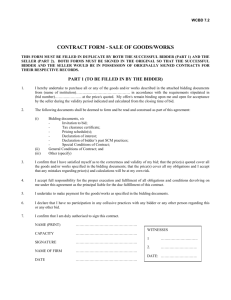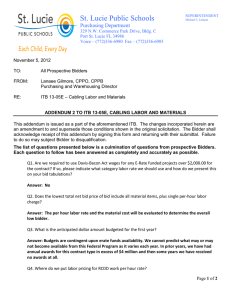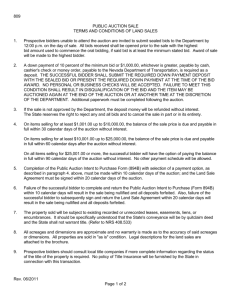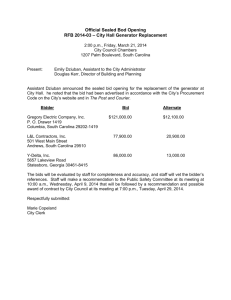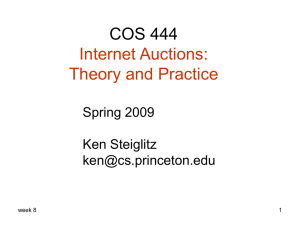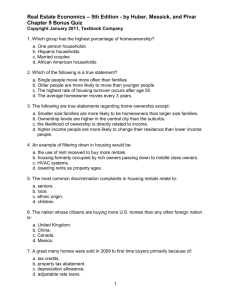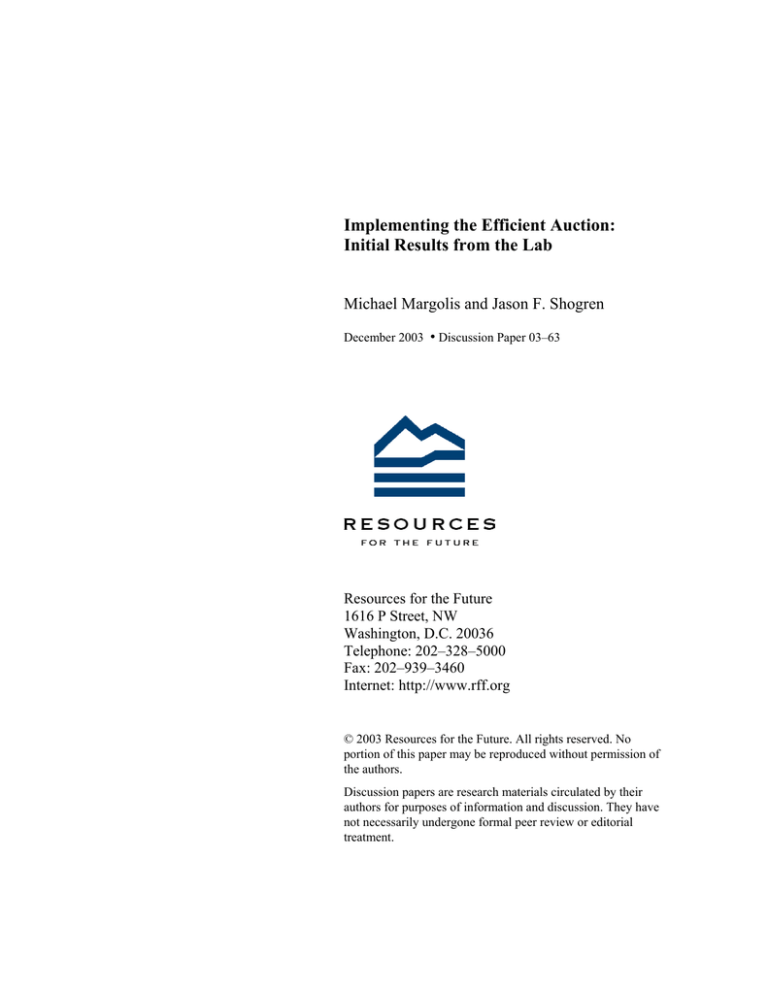
Implementing the Efficient Auction:
Initial Results from the Lab
Michael Margolis and Jason F. Shogren
December 2003 • Discussion Paper 03–63
Resources for the Future
1616 P Street, NW
Washington, D.C. 20036
Telephone: 202–328–5000
Fax: 202–939–3460
Internet: http://www.rff.org
© 2003 Resources for the Future. All rights reserved. No
portion of this paper may be reproduced without permission of
the authors.
Discussion papers are research materials circulated by their
authors for purposes of information and discussion. They have
not necessarily undergone formal peer review or editorial
treatment.
Implementing the Efficient Auction: Initial Results from the Lab
Michael Margolis and Jason F. Shogren
Abstract
The efficient auction is designed to induce truthful bidding for bidders with affiliated values.
Herein we implement the auction in the lab, and observe that inexperienced people can bid systematically
in this more complex environment, albeit yielding a flatter bid function than the truthful one.
Key Words: auction, affiliation, experiments, valuation
JEL Classification Numbers: C9, D44
Contents
1. Introduction........................................................................................................................ 1
2. Experimental Design.......................................................................................................... 2
3. Results ................................................................................................................................. 4
References................................................................................................................................ 7
Resources for the Future
Margolis and Shogren
Implementing the Efficient Auction: Initial Results from the Lab
Michael Margolis and Jason F. Shogren∗
1. Introduction
Over the past two decades, Vickrey’s (1961) second-price auction has been widely used
in the lab to elicit values for private value goods like neoteric food products.1 The auction is
demand revealing and efficient in theory, is relatively simple to explain to people (for example,
highest bidder wins, pays second-highest bid), and each person’s bid depends only on his or her
own value for the good rather than on every bidder’s value, as in first-price auctions.2 But if
bidders have affiliated values over a good—that is, if the value to one bidder depends in part on
information available only to some other bidders—then the auction is neither demand revealing
nor efficient (Milgrom and Weber, 1982; McAfee and McMillan, 1987). Affiliated value
auctions occur, for example, in the sale of oil drilling rights, in which each firm has its own
information and the winner’s ultimate costs could best be estimated if all information were
pooled (Porter, 1995).
Dasgupta and Maskin (2000) address the problem posed by affiliated values by
constructing a clever generalization of the Vickrey auction. In their efficient auction, each bidder
expresses his or her bid as a function of what other bidders say (unverifiably) about their private
information. The auctioneer takes these contingent bids and calculates each bidder’s bid, then
determines the high bidder and the price, which is based on all bid functions other than the high
∗
Michael Margolis is a Fellow at Resources for the Future and Jason Shogren is a professor of natural resource
conservation and management at the University of Wyoming.
1
Lab auctions have been used to value neoteric agricultural and commercial products prior to field marketing such
as genetically modified products, irradiated food products, safer food, growth-hormone-treated meat and dairy
products, vacuum-packaged meat, and fresh foods and produce (see Shogren, 2004, for an overview). Affiliation
might arise in these repeated auctions if posted prices transform independent private values into affiliated values
because the prices signal potential common outside options or commonly perceived, but unknown, characteristics of
the product (Harrison et al., 1995).
2 Truthful bidding is the weakly dominant strategy. A person who underbids risks foregoing a profitable purchase;
overbidding risks making an unprofitable purchase.
1
Resources for the Future
Margolis and Shogren
bidder. Given affiliation, the key is that the auction once again separates what bidders pay from
what they say, such that efficiency is achieved—the bidder with highest value wins the auction.
An open question is how to implement the efficient auction, which is more complex to
explain to bidders than the classic Vickrey auction. We say this because laboratory tests of the
second-price auction reveal that bidders, especially inexperienced ones, frequently do not make
rational bids at the individual level (see Kagel, 1995). If bidders have difficulty with the secondprice auction, they might find the efficient auction even more challenging. Herein we examine
an experimental design that implements the efficient auction in a one-shot, two-person setting.
Recognizing that strictly rational behavior is unlikely, we purposefully set a low baseline and ask
whether inexperienced bidders without feedback can do better than random. Overall, the results
suggest our implementation of the efficient auction can induce systematic bidding behavior in a
one-shot setting. Subjects, however, showed a strong tendency to bid near the expected value of
the good, underweighting their private information relative to the optimal bid.
2. Experimental Design
To minimize subject confusion (given observed behavior in pilot tests), we do not ask
bidders to submit a bid function; rather, we ask each bidder to submit two bids—one for the
lowest value signal that might be received by the other bidder and another for the highest value
signal. We then create a linear bid function (bidding line) by plotting the two bids on a chart and
running a line from one to the other.3 We explain the efficient auction to our inexperienced
subjects in five steps—the resale value, bids, auction winner, auction price, and payoffs.4 We
describe each step below as if we are explaining it to the subject:
Step 1. Resale value. The resale value is the price the monitor will pay you to buy back
the product. You will not know your resale value until the end of each round. At the beginning
3
Nothing in the proof that the auction is efficient rules out constraint to linear bid functions (Dasgupta and Maskin,
2000).
4
Exact experimental instructions appear in the appendix.
2
Resources for the Future
Margolis and Shogren
of the round, you will be given a piece of private information denoted PvtInfo(You). This
PvtInfo(You) will be determined randomly from a value between $1 and $20, in one dollar ($1)
increments {1, 2, 3, …, 10, 11, 12, …, 18, 19, 20}. Each amount has an equal chance to be
selected. The other bidder will also be given his or her private information, PvtInfo(Other
bidder). His or her PvtInfo(Other bidder) will also be determined randomly from a value
between $1 and $20, in one dollar ($1) increments {1, 2, 3, …, 10, 11, 12, …, 18, 19, 20}. Each
amount has an equal chance to be selected.
Your resale value is the sum of your private information and half the other bidder’s
information: Resale Value(You) = $PvtInfo(You) + [0.5 x $PvtInfo(Other bidder)]. For
example, if your true private information is $5 and the other bidder’s true private information is
$20, your resale value is Resale Value(You) = $5 + [0.5 x $20] = $15; or if it is $11 for you and
$12 for the other bidder, Resale Value(You) = $11 + [0.5 x $12] = $17. Overall, your resale
value could range from a low of $1.50 ($1 for you, $1 for other bidder) to a high of $30 ($20 for
you, $20 for other bidder). Likewise, the other bidder has a resale value that is determined by his
or her true private information and your true private information.
Step 2. Bids. You will be asked to submit two bids once you receive your true private
information. The other bidder is asked to do the same. Given your revealed $PvtInfo(You):
Bid-Low(You) = $__________
If the reported $PvtInfo(Other bidder) = $1
Bid-High(You) = $__________
If the reported $PvtInfo(Other bidder) = $20
These two bids will be combined to create your bidding line (See Figure 1). For
example, suppose Bid-Low(You) = $7, if the reported $PvtInfo(Other bidder) = $1; BidHigh(You) = $19, if the reported $PvtInfo(Other bidder) = $20. Likewise, the other bidder’s
bids are conditional on what you report as your private information. He or she will also create a
bidding line based on your private information.
Step 3. Auction winner. The winner of the auction is determined by where the two
bidding lines intersect (See Figure 2). If the two bidding lines intersect above the bids are equal
line, then your bid is greater than the other player’s and you win. If the bidding lines intersect
below the line, then your bid is lower than the other player’s, and he or she wins. The example
in the figure shows that your bid is greater, so you win.
3
Resources for the Future
Margolis and Shogren
Step 4. Auction price. The auction price is then determined by what we call the sorting
line (See Figure 3). The sorting line starts from the origin. If you win, your auction price is set
by where the other player’s bidding line intersects the sorting line. If the other player wins, his
or her auction price is set by where your bidding line intersects the sorting line.
Step 5. Payoffs. Your payoff for the auction is then determined. If you win, your payoff
for that round is: Payoff(you win) = Resale Value(You) – Auction price. If you lose, your
payoff for that round is: Payoff(you lose) = $0.
3. Results
We are interested in two questions about our bidders’ behavior. First, did they use truthful
bid functions? Second, did the auctions produce efficient outcomes? A positive answer to the
first question implies a positive answer to the second, but not the reverse—a positive answer to
the second question does not imply a positive answer to the first.
A truthful bid function reveals both the bidder’s private information and the dependence
of his or her resale value on the other bidder. That means the low bid is equal to the bidder’s
private value, and the high bid is equal to what the bidder’s resale value would be if the other
bidder’s private value is at the upper limit. Within each round, the only treatment that varies
among subjects is the private information. In the context of regressing each bid on a constant
term and private information, the hypothesis of efficient behavior is βL=(βL,1) and βH=(βH,1),
where βi denotes the regression coefficients for outcome i ∈ {Highbid , Lowbid} and βi is the
product of the resale line slope and the top (H) or bottom (L) of the private information range,
e.g., βH=$10 in the Step 1 example.
Table 1 presents results of that regression. While our subjects’ actual behavior is not
perfectly described by the optimal bidding strategy, their bidding behavior was systematic. The
first four columns present coefficient estimates for individual rounds (the first and fourth only in
each of the two treatments). In each round, truthful bid hypothesis could be rejected in the OLS
4
Resources for the Future
Margolis and Shogren
estimates for at least one of two bids, and in the SUR5 estimates for the two bids combined. The
final two columns present panel method estimates for the combined rounds in each session.6 The
truthful bidding hypothesis is not straightforward to test in the panel context because the βi vary
across rounds, but it is clear from the standard errors that the low bids are not optimal. The high
bids are not statistically far from the optimum, but this seems to be an indication of noisy data.
In no case is a coefficient tightly estimated near its optimal value.
In almost every sample and statistical treatment, the coefficient on private value is below
one. The only exceptions are the high bids from the first session. This means that, in general,
bidders did not respond as strongly as they should to their private signals; instead, they offered
bids that were about what the average subject offers. While this behavior might indicate that
bidders lacked confidence in their understanding of the auction and preferred to avoid behavior
that appeared extreme, it is consistent with observed bidding behavior in the classic second-price
auction (see Kagel, 1995). For example, Shogren et al. (2001) estimated regression lines flatter
than the perfect-revelation line, with positive intercepts and slopes below unity for both the
second-price auction and its variant, the random nth-price auction.
This imperfection of subjects’ behavior need not, however, translate into inefficient
outcomes. We assess the efficiency of the auction by (a) randomly pairing subjects within each
round, (b) determining the winner, and (c) classifying the simulated two-player auction as
efficient if the winner had the higher private value. We replicated this 500 times with
resampling. Overall, 57.66 percent of the simulated auctions were efficient, with bootstrap
standard errors of around 10% (see Table 2 for round by round results.) While subjects did not
perform significantly better by bootstrap criteria, they performed better than a coin flip in every
single round.
Overall, the results from this initial exploration suggest this relatively complicated
auction can stay afloat in conditions involving inexperienced bidders and no feedback. If bidders
gain experience through many trials and more information on payoffs through computer
5
OLS stands for Ordinary Least Squares and SUR for Seemingly Unrelated Regression.
6
We present the random effects for the first and fixed effects for the second because Hausman’s test for the
hypothesis maintained in random effects estimation was rejected for the second session only.
5
Resources for the Future
Margolis and Shogren
implementation, one can expect greater efficiency levels for the efficient auction. Given that the
efficient auction works in the lab setting, it should also work in the “real world” with more
reinforcement of rational bidding behavior.
6
Resources for the Future
Margolis and Shogren
References
Dasgupta, P., and E. Maskin. 2000. Efficient Auctions. Quarterly Journal of Economics 115:
341–388.
Harrison, G., R. Harstad, and E. Rutström. 1995. Experimental Methods and the Elicitation of
Values. Working paper. Columbia, SC: Department of Economics, University of South
Carolina.
Kagel, J. 1995. Auctions: A Survey of Experimental Research. In Handbook of Experimental
Economics, edited by J. Kagel and A. Roth. Princeton, NJ: Princeton University Press,
501–585.
McAfee, R.P., and J. McMillan. 1987. Auctions and Bidding. Journal of Economic Literature
25: 699–754.
Milgrom, P., and R. Weber. 1982. A Theory of Auctions and Competitive Bidding.”
Econometrica 50: 1089–1122.
Porter, R.H. 1995. The Role of Information in U.S. Offshore Oil and Gas Lease Auctions.
Econometrica 63: 1–27.
Shogren, J. 2004. Experimental Methods and Valuation. In Handbook of Environmental
Economics, edited by K.-G. Mäler and J. Vincent. Amsterdam: North-Holland Elsevier
Science. (in press).
Shogren, J., M. Margolis, C. Koo, and J. List. 2001. A Random nth-price Auction. Journal of
Economic Behavior and Organization 46: 409–421.
Vickrey, W. 1961. Counterspeculation, Auctions and Competitive Sealed Tenders. Journal of
Finance 16: 8–37.
7
Resources for the Future
Margolis and Shogren
Figure 1. Bid Line
Your Bid ($)
Your Bid Line
20
18
16
14
12
10
8
6
4
2
0
12
13
14
15
16
17
18
19
20
Reported Private Information of Other bidder
8
21
22
Resources for the Future
Margolis and Shogren
Figure 2. Bid functions and the determination of winner and loser
Your
Signal and Bid
The
Other Bidder’s
Bidding Line
Bids are Equal
Your Bidding Line
Your Bid
The Other Bidder’s
Bid
Bid(other player)
9
The Other
Bidder’s Signal
Resources for the Future
Margolis and Shogren
Figure 3. Determination of market price
Your Signal
and Bid
The Other
Bidder’s
Bidding Line
The Sorting Line
Your Bidding Line
Your Bid B(you)
The Auction Price
The other bidder’s
Bid, or Bid (other
player)
10
The Other
Bidder’s Signal
Resources for the Future
Margolis and Shogren
Table 1: Coefficients of regression of HIGHBID and LOWBID on PRIV (Private signal)
0-1
0-4
1-1
1-4
0-RE
1-FE
0.165
-80.80
12.57
8.98
28.59
(7.77)1.
(157.51)
(1.88)
(0.929)
(21.1)
1.46
10.88
0.700
0.559
-0.1700
(0.469)
(14.37)
(0.292)
(0.312)
(1.476) (1.35)
1.98
4.46
6.452
3.83
4.197
(7.15)
(3.69)
(1.82)
(0.805)
(1.28)
0.892
0.465
0.467
0.841
0.614
0.709
(0.431)
(0.336)
(0.282)
(0.270)
(0.92)
(0.084)
HIGHBID
Constant
PRIV
1.23
LOWBID
Constant
PRIV
TEST OF TRUTHFUL BID HYPOTHESIS
HIGBID
LOWBID
SUR
F2,50=8.44
F2,50=0.87 F2,50=0.63 F2,50=6.84
p = 0.007
p=0.4268 p=0.536
p=0.002
F2,50=30.43 F2,50=26.33 F2,50=15.43F2,50=0.29
p = 0.000
p = 0.000 p = 0.000 p = 0.748
χ 42 =75.54
χ 42 =58.72 χ 42 =37.98 χ 42 =17.07
p = 0.000
p = 0.000 p = 0.000 p =0.002
Numbers in parentheses ( ) are the lowest estimated standard errors, i.e., SUR standard
errors in Columns 1–4, GLS standard errors in Column 5, OLS standard errors in Column 6.
Robust standard errors were approximately the same in all cases.
11
Resources for the Future
Margolis and Shogren
Table 2: Mean efficiency of simulated auctions
SESSION:
ROUND
% Efficient
Bootstrap SE
0:1
0.564
0.091
0:2
0.512
0.095
0:3
0.581
0.099
0:4
0.559
0.099
1:1
0.587
0.092
1:2
0.604
0.097
1:3
0.568
0.101
1:4
0.639
0.093
12
Resources for the Future
Margolis and Shogren
APPENDIX: Experimental Instructions
6 December 2002
Instructions
Welcome. This is an experiment in decisionmaking that will take approximately an hour
to complete. At the end of the experiment, you will be paid in cash for participating. How much
you earn depends on your decisions and chance.
•
Please do not talk and do not try to communicate with any other participants during the
experiment. If you have a question, please raise your hand. Anyone who does talk to another
participant during the experiment will be asked to leave and forfeit any moneys earned.
•
You can leave the experiment at any time without penalty.
OVERVIEW:
•
You are in an Auction for a product. The highest bid wins the auction.
•
If you win the auction, you buy the product at the Auction Price and sell it back to the
monitor at your Resale Value.
•
Your payoff (total gain or loss) is
•
Resale Value – Auction Price
•
If you lose the auction your payoff is zero.
•
Your take-home pay at the conclusion of the experiment will be the sum of all your
payoffs plus $10.
13
Resources for the Future
Margolis and Shogren
•
There is one other bidder in each auction—you do not know who he or she is.
•
There will be many rounds of the auction.
•
In each round, you will be matched with a different other bidder.
•
Everyone is receiving identical instructions, so you know that the other bidder’s payoffs
depend on you in the same way yours depend on him or her.
14
Resources for the Future
Margolis and Shogren
The auction has five parts that you need to understand:
Part I. Resale Value
RESALE VALUE. The resale value is the price the monitor will pay you to buy back the
product.
•
You will not know your Resale Value until the end of each round.
•
At the beginning of the round, you will be given a piece of Private Information denoted
PvtInfo(You).
•
This PvtInfo(You) will be determined randomly from a value between $1 and $20, in one
dollar ($1) increments {1, 2, 3, …, 10, 11, 12, …, 18, 19, 20}. Each amount has an
equal chance to be selected.
•
The other bidder will also be given his or her private information, PvtInfo(Other bidder).
His or her PvtInfo(Other Bidder) will also be determined randomly from a value between
$1 and $20, in one dollar ($1) increments {1, 2, 3, …, 10, 11, 12, …, 18, 19, 20}.
Each amount has an equal chance to be selected.
•
Your Resale Value is the sum of your private information and half the other bidder’s
information.
Resale Value(You) = $PvtInfo(You) + [0.5 x $PvtInfo(Other bidder)]
•
For example, if your true private information is $5 and the other bidder’s true private
information is $20, your resale value is
Resale Value(You) = $5 + [0.5 x $20]
= $15
or if it is $11 for you and $12 for the other bidder
Resale Value(You) = $11 + [0.5 x $12]
15
Resources for the Future
Margolis and Shogren
= $17
•
Overall, your RESALE VALUE could range from a low of $1.50 ($1 for you, $1 for
other bidder) to a high of $30 ($20 for you, $20 for other bidder).
•
Likewise the other bidder has a resale value too, which is determined by his or her true
private information and your true private information
PART II. BIDS
You will be asked to submit two bids once you receive your true private information. The other
bidder is asked to do the same.
Given your revealed $PvtInfo(You):
Bid-Low(You) = $__________ If the reported $PvtInfo(Other bidder) = $1
Bid-High(You) = $__________ If the reported $PvtInfo(Other bidder) = $20
These two bids will be combined to create your BIDDING LINE
For example, suppose
Bid-Low(You) = $7
Bid-High(You) = $19
If the reported $PvtInfo(Other bidder) = $1
If the reported $PvtInfo(Other bidder) = $20
16
Resources for the Future
Margolis and Shogren
Your Bid Line
20
15
10
5
0
12
13
14
15
16
17
18
19
20
21
22
Reported Private Information of Other bidder
Likewise the other bidder’s bids are conditional on what you report as your private
information. He or she will also create a bidding line based on your private information.
PART III. Who Wins the Auction?
•
The winner of the auction is determined by where the two Bidding Lines intersect.
•
If the two bidding lines intersect above the sorting line, then your bid is greater than the
other player, and you win
•
If the bidding lines intersect below the sorting line, then your bid is lower than the other
player, and he or she wins
•
The example below shows that your bid is greater, so you win
17
Resources for the Future
Your Signal
and Bid
Margolis and Shogren
The
Other Bidder’s
Bidding Line
Bids are Equal
Your Bidding Line
Your Bid
B(you)
The other bidder’s
Bid Bid(other
player)
18
The Other
Bidder’s Signal
Resources for the Future
Margolis and Shogren
PART IV. AUCTION PRICE
•
The auction price is then determined by what we call the SORTING LINE.
The SORTING LINE starts from the origin
•
If you win, your Auction price is set by where the other player’s Bidding Line
intersects the Sorting Line
•
If the other player wins, his or her Auction price is set by where your Bidding Line
intersects the Sorting Line
19
Resources for the Future
Margolis and Shogren
The Other
Bidder’s
Bidding Line
Your Signal and
Bid
The Sorting Line
Your Bidding Line
Your Bid
B(you)
The Auction
Price
The other bidder’s Bid
Bid(other player)
20
The Other
Bidder’s Signal
Resources for the Future
Margolis and Shogren
PART V. PAYOFFS
Your payoff for the auction is then determined:
•
If you win, your payoff for that round is:
Payoff(you win) = Resale Value(You) – Auction price
•
If you lose, your payoff for that round is:
Payoff(you lose) = $0.
21
Resources for the Future
Margolis and Shogren
Summary: Each round has 9 steps:
Step 1.
Your true private information is revealed only to you:
$PvtInfo(You) = $___
Step 2.
You make two bids. Which bid is used in the auction depends on what the
other bidder decides to report to you about his or her reported private
information
Bid-Low $__________ if the other bidder reports $1
Bid-High $__________ if the other bidder reports $20
Your BID LINE is the determined given these two bids
The other bidder makes his or her bids in a similar way—his or her
auction bid will depend on your reported private information.
Step 3.
Your bid and the other player’s bid are determined by where the two
Bidding Lines intersect
Your Bid = $________
The other player’s Bid = $______________
22
Resources for the Future
Margolis and Shogren
Step 4.
The winner of the auction is the player with the highest bid
Step 5.
If you are the winner, your AUCTION PRICE is calculated by where the
other player’s Bidding line intersects the SORTING LINE
Step 6.
If you win, your payoff for that round is then calculated as
Payoff = Resale value – Auction price.
If you lose, your payoff is $0.
End of round.
23
Resources for the Future
Margolis and Shogren
Are there any questions at this point?
Please complete the following questions.
1. Each auction has how many bidders _________________?
2. You bid against the same other bidder in each round?
3. For each auction, you submit how many bids?
YES NO
1 2 3
4. Whoever has the highest bid wins the auction? YES NO
5. Your BID is determined by the intersection of:
a) Your Bidding LINE and your private information.
b) Your Bidding LINE and the other bidder’s Bidding line.
c) the other bidder’s Bidding LINE and your private information.
d) the other bidder’s Bidding LINE and the other bidder’s private information.
6. If you win the auction, your AUCTION PRICE is determined by where:
a) Your Bidding LINE and the SORTING LINE cross
b) The other bidder’s Bidding LINE and the SORTING LINE cross
7. Your RESALE VALUE is determined by the $1 Flat Payment plus:
a) Your private information and the other bidder’s private information
b) Your private information alone
c) The other bidder’s private information alone
24


